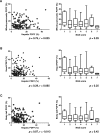Three-dimensional analysis of pancreatic fat by fat-water magnetic resonance imaging provides detailed characterization of pancreatic steatosis with improved reproducibility
- PMID: 31790429
- PMCID: PMC6886808
- DOI: 10.1371/journal.pone.0224921
Three-dimensional analysis of pancreatic fat by fat-water magnetic resonance imaging provides detailed characterization of pancreatic steatosis with improved reproducibility
Abstract
Background: Since pancreatic steatosis is reported as a possible risk factor for pancreatic cancer, the development of a non-invasive method to quantify pancreatic steatosis is needed. Proton density fat fraction (PDFF) measurement is a magnetic resonance imaging (MRI) based method for quantitatively assessing the steatosis of a region of interest (ROI). Although it is commonly used for quantification of hepatic steatosis, pancreatic PDFF can greatly vary depending on the ROI's location because of the patchy nature of pancreatic fat accumulation. In this study, we attempted to quantify pancreatic steatosis by fat-water MRI with improved reproducibility.
Methods: Using the MRI images of 159 patients with nonalcoholic fatty liver disease, we attempted to calculate the average PDFF of whole pancreas. We set ROIs covering the entire area of the pancreas appearing in every slice and calculated the average PDFF from all the voxels included in the pancreas. We named this average value as whole-pancreatic PDFF and evaluated the reproducibility of the measured values. In addition to whole-pancreatic PDFF, we measured the average PDFF of the pancreatic head (head-PDFF) and that of the pancreatic body plus tail separately and analyzed their correlation with the clinical characteristics of the patients.
Results: The mean inter-examiner coefficient of variation of the whole-pancreatic PDFF was 11.39%. The whole-pancreatic PDFF was correlated with age (p = 0.039), body mass index (p = 0.0093) and presence/absence of diabetes (p = 0.0055). The serum level of low-density lipoprotein cholesterol was inversely correlated with the head-PDFF.
Conclusion: We developed a new measurement method of the pancreatic PDFF with greater reproducibility. Using this method, we characterized pancreatic steatosis in detail. This novel measurement method allows accurate estimation of the severity of pancreatic steatosis and is therefore useful for the detailed characterization of pancreatic steatosis.
Conflict of interest statement
The authors have declared that no competing interests exist.
Figures




References
MeSH terms
Substances
LinkOut - more resources
Full Text Sources
Medical

